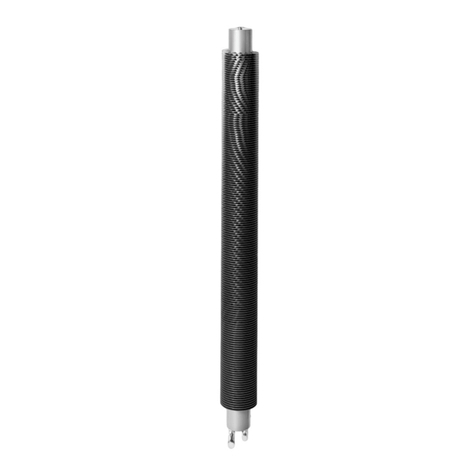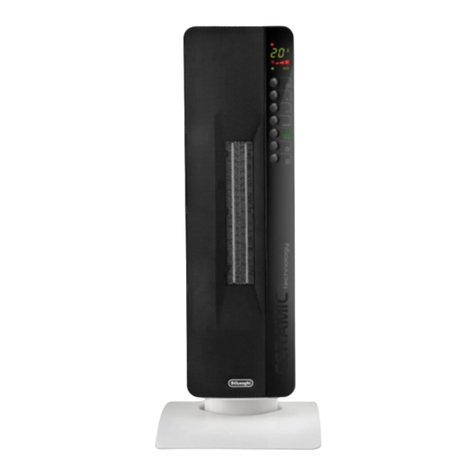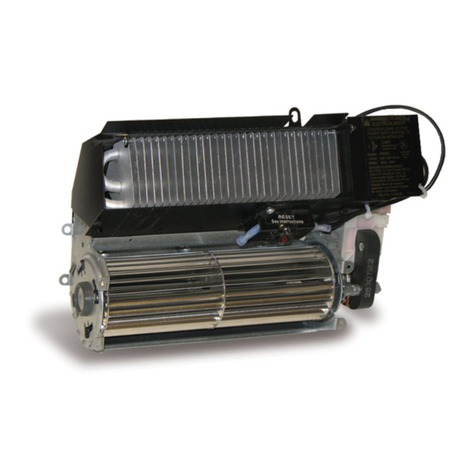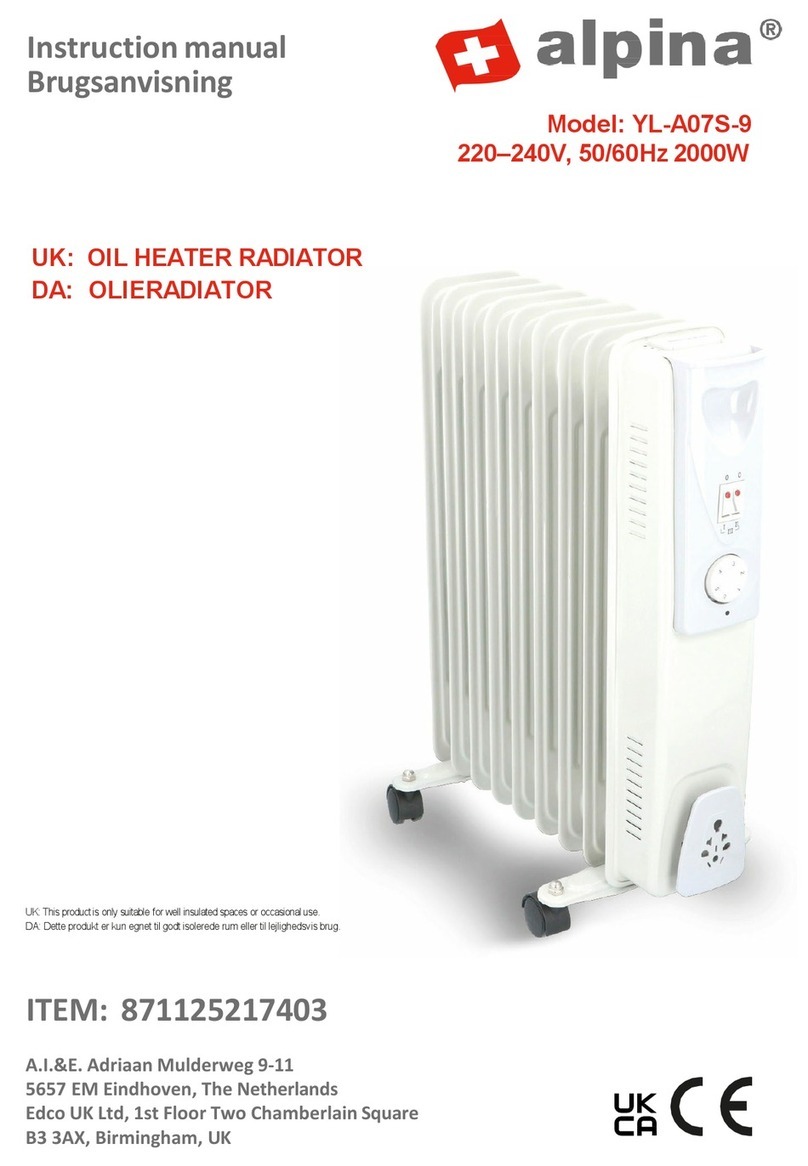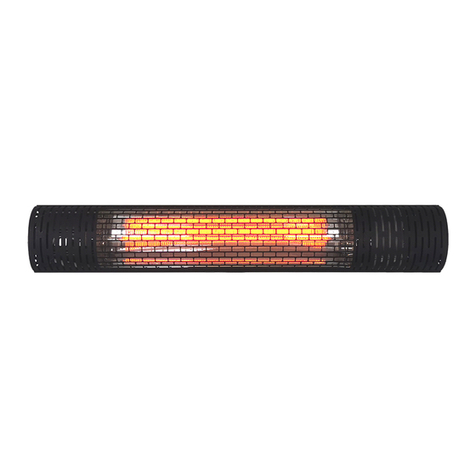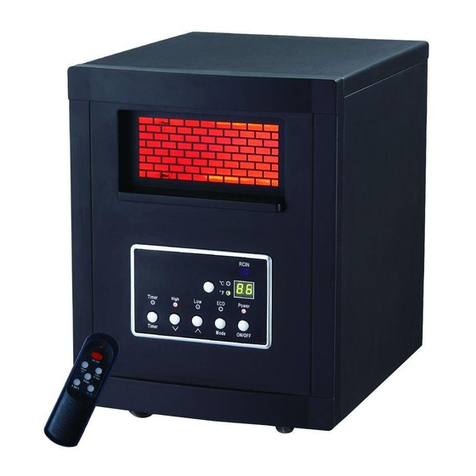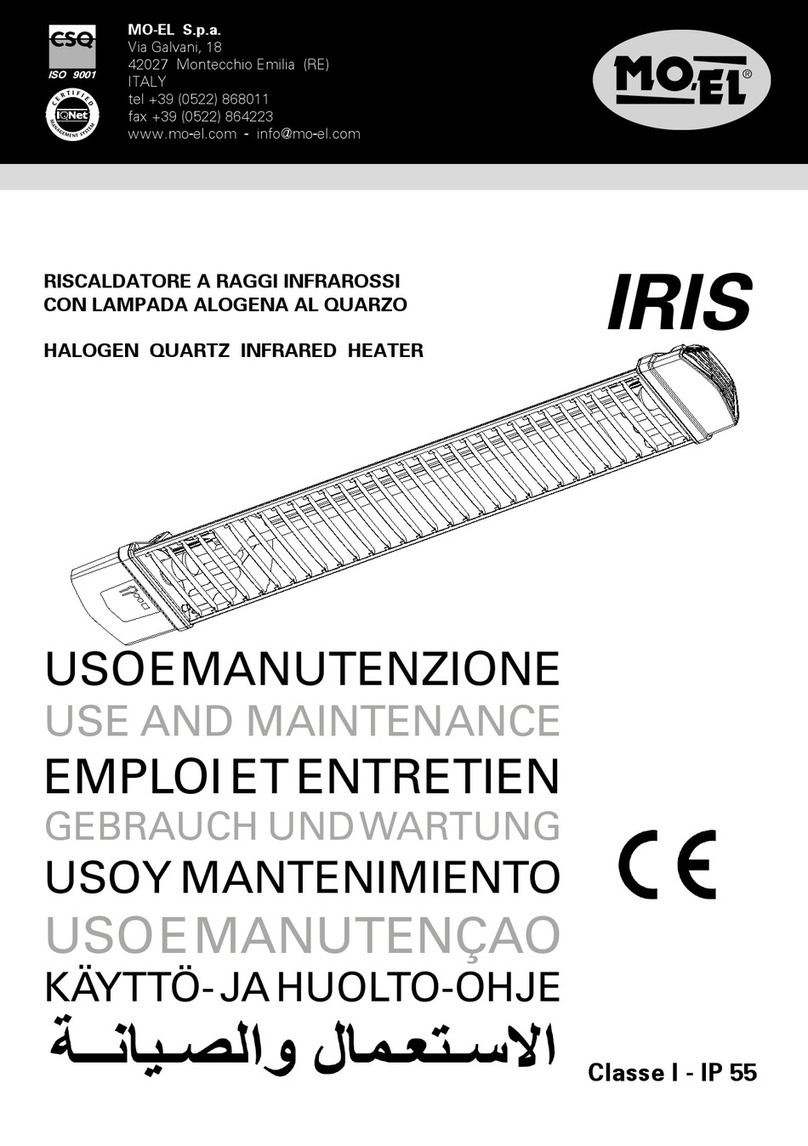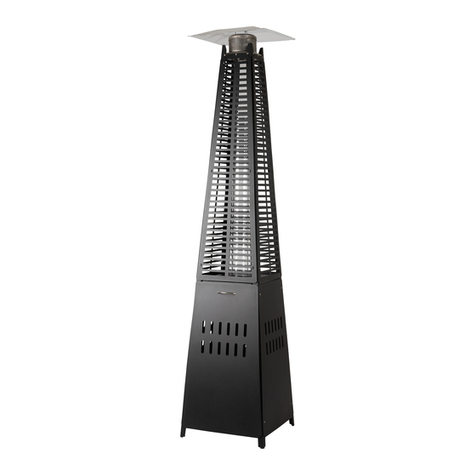Raychem H908 User manual

Installation Instructions
H908
WinterGard Plug-in Power Connection Kit
with End Seal
Description
The H908 is a plug-in, ground-fault-protected power connection kit for use
with WinterGard H311, H611, and H612 120-V heating cables.
This kit ensures compliance with Raychem and NEC requirements for
ground-fault protection of equipment. It does not protect people against the
hazards of electrical shock. The kit includes materials for one power
connection and end seal. All WinterGard heating cables are designed for
water-pipe freeze protection applications. Only the H612 heating cable can be
used for both pipe freeze protection and roof and gutter de-icing applications.
For additional technical support call Raychem at 800-542-8936.
Tools Required
• Needle nose pliers • Propane torch or heat gun
• Utility knife • Panduit crimp tools CT100 and CT570
• Diagonal cutters
Additional Materials Required
• Grounded, UL Listed 15-amp, 120-volt receptacle (receptacle must be
approved for wet locations if exposed to weather)
• Additional cable ties may be required for roof and gutter applications.
• Your application may require additional WinterGard accessories; for exam-
ple, H903 application tape for pipe applications; H913/H914 roof clips
and/or H915 downspout hangers for roof and gutter de-icing applications.
Kit Contents
Item Qty Description
A 1 Gel-filled end seal
B 1 Heat-shrinkable tube (8˝ long x 1˝ dia.)
C 1 Heat-shrinkable tube (5˝ long x 3/4˝ dia.)
D 2 Mastic strips (2˝ long x 1˝ wide)
E 2 Heat-shrinkable tubes (1˝ long x 1/8˝ dia.)
F 2 Insulated bus wire crimps
G 1 Uninsulated braid crimp
H 2 Warning labels for pipe-trace applications
I 2 De-icing and snow melting equipment labels
J 1 Plug-in ground-fault equipment protection device
K 2 Clamp ties
L 2 Black cloth tapes (6˝ long x 1˝ wide)
D
E
F
G
A
B
J
K
L
C
I
H
WARNING
Fire and Shock Hazard
Self-regulatingelectrical
heatingcableattachedtothispipe:
Disconnectbeforesevicing
Electric Deicingand
SnowMeltingEquipment
onPremises
WARNING
FireandShockHazard
Self-regulatingelectrical
heatingcable attached to this pipe:
Disconnectbefore sevicing
Electric Deicingand
SnowMeltingEquipment
onPremises
Approvals
718K Pipe Heating Cable, DESIG. 3A, 3B, 3C, 3D, 2E
or 877Z De-Icing and
Snow Melting Equipment
®
R
LISTED
These components are electrical devices. They must be
installed correctly to ensure proper operation and to
prevent shock or fire. Carefully follow all of the installa-
tion instructions and read these important warnings.
• To minimize the danger of fire from sustained
electrical arcing if the heating cable is damaged or
improperly installed, and to comply with the
requirements of Raychem and the 1996 National
Electrical Code, ground-fault equipment protection
must be used on each heating cable branch circuit.
Arcing may not be stopped by conventional circuit
protection.
• Component approvals and performance are based
on the use of specified parts only. Do not substitute
parts or use vinyl electrical tape.
• The black heating-cable core is conductive and can
short. It must be properly insulated and kept dry.
• Keep components and heating cable ends dry
before and during installation.
• Damaged bus wires can overheat or short. Do not
break braid or bus wire strands when scoring the
jacket or core.
• Bus wires will short if they contact each other.
Keep bus wires separated.
• Heat-damaged components can short. Use a heat
gun or a torch with a soft, yellow, low-heat flame,
not a blue focused flame. Keep the flame moving to
avoid overheating, blistering, or charring the heat-
shrinkable tubes. Avoid heating other components.
Replace any damaged parts.
• Use only fire-resistant insulation materials such as
fiberglass wrap.
• Leave these installation instructions with the user
for future reference.
Charring or burning the heat-shrinkable tubes
in this kit will produce fumes that may cause eye,
skin, nose, and throat irritation. Consult Material
Safety Data Sheet RAY/3122.
24-hour emergency telephone:
CHEMTREC (800) 424-9300.
Non-emergency health and safety information:
(650) 361-4907.
WARNING: CAUTION:
R

2
H908 Design and Installation Information for Heating Cable on Pipes Only
(WinterGard H311, H611, and H612 Heating Cables)
Table 1. For METAL pipes with fiberglass insulation or equivalent (based on 40°F maintain temperature, 10% safety factor)
Articles 422 and 427 of the National Electrical
Code govern the installation of WinterGard
heating cable for pipe freeze protection.
Important: For the Raychem HTS warranty to
be valid, you must comply with all the require-
ments outlined in these guidelines.
All thermal and design information provided
here is based upon a “standard” installation
with heating cable fastened to an insulated pipe.
For any other application or method of installa-
tion, consult Raychem HTS at (800) 542-8936.
Make sure that the heating cable being used is
suitable for your application. Refer to the Heat
Systems Application and Design Guide (H53585)
for heating cable application information.
1. Determine the heating cable type.
Use Table 1 to select heating cables for insu-
lated metal pipes. Use Table 2 to select heat-
ing cables for insulated plastic pipes. Read
across the table to find your pipe size, then
drop down to the line corresponding to the
lowest air temperature for that appli-cation
and the correct insulation thickness. The cell
at that intersection has a particular shading
and may have a number. The shading indi-
cates which heating cable to use (key to the
shading appears above the table headings). A
number represents the spiraling ratio (feet of
heating cable per foot of pipe).
If no number appears in the cell, straight trace
the pipe. If a number does appear in the cell,
spiral trace the pipe.
If your spiraling ratio is 2.0, multiple trace the
pipe using two straight traces at the 4 o’clock
and 8 o’clock positions.
If your spiraling ratio is 3.0, multiple trace the
pipe using three straight traces at the 11
o’clock or 1 o’clock position, and at the 4
o’clock and 8 o’clock positions.
Example 1:
Pipe size: 1"
Lowest air temp.: 0°F
Insul. thickness: 1/2"
Metal pipe:
WinterGard H311
Plastic pipe:
WinterGard Plus H611
or WinterGard Wet H612
Example 2:
Pipe size: 2 1/2"
Lowest air temp.: –20°F
Insul. thickness: 1/2"
Metal pipe:
WinterGard Plus H611
or WinterGard Wet H612
(Use 1.3 feet of heating cable per foot of pipe.)
Plastic pipe:
WinterGard Plus H611
or WinterGard Wet H612
(Use two straight traces at the 4 o’clock and
8 o’clock positions.)
2.0
1.3
Heating cable selection and design
Electrical codes
Lowest air
temp. (°F) Insulation
thickness
Nominal pipe size
1/2" 8"6"4"3"2 1/2"2"1 1/2"1 1/4"1"3/4"
1/2"
1"
1 1/2"
1/2"
1"
1 1/2"
2"
1/2"
1"
1 1/2"
2"
0
–20
–40
3.01.81.3
1.3
3.01.81.51.31.1
1.91.51.1
1.31.1
3.02.01.71.41.21.1
3.01.91.41.1
1.71.4
1.41.1
Key to Table 1: = H311 = H611, H612,
H621, H622 = Use a thicker insulation
Table 2. For PLASTIC pipes with fiberglass insulation or equivalent (based on 40°F maintain temperature, 10% safety factor)
3.02.01.7
2.0
3.01.81.51.31.1
3.01.8
1.4
3.01.7
3.03.02.01.81.51.1
3.0
1.61.41.2
3.03.0
3.01.8
1.41.2
1.61.2
1.2 1.5
2.0
1.21.1
1.31.1
1.71.4
1.1
1.1 1.9
1.71.41.21.1
1.31.1
Lowest air
temp. (°F) Insulation
thickness
Nominal pipe size
1/2" 8"6"4"3"2 1/2"2"1 1/2"1 1/4"1"3/4"
1/2"
1"
1 1/2"
1/2"
1"
1 1/2"
2"
1/2"
1"
1 1/2"
2"
0
–20
–40
Key to Table 2: = H311 = H611, H612
H621, H622 = Use a thicker insulation

3
2. Calculate the total heating cable length.
Pipe length ×spiraling ratio
+ 4 ft ×# gate/globe valves ×valve length (ft) ×spiraling ratio
+ 2 ft ×# ball/butterfly valves ×valve length (ft) ×spiraling ratio
+ 2 ft ×# flanges ×pipe diameter (ft) ×spiraling ratio
+ 2 ft ×# pipe supports ×pipe diameter (ft) ×spiraling ratio
+ 1 ft for each power connection
+ 2 ft for each splice connection
+ 3 ft for each tee connection
= Total heating cable length (ft)
3. Determine the maximum heating cable circuit length allowed.
See Table 3 on the next page. Ensure that your circuits do not exceed
the maximum circuit length listed in Table 3. If necessary, use additional
shorter circuits.
Example (taken from Example 2 [on metal pipe], pg. 2):
Pipe length: 50 ft
Spiral ratio: 1.3 (from Table 1, pg. 2)
Globe valves: 3 (each 0.5 ft long)
Pipe supports: 10 supports for 1" pipe
Power connections: 1
Splice connections: 1
End Seals: 1
WinterGard heating cable required:
Pipe length
×
spiral ratio = 50 ft ×1.3 = 65.0 ft
3 globe valves (.5 ft each) = 4 ft ×3 ×.5 ×1.3 = 7.8 ft
10 pipe supports = 2 ft ×10 ×.085* ×1.3 = 2.2 ft
1 power connection = 1 ft ×1 = 1.0 ft
1 splice connection = 2 ft ×1 = 2.0 ft
1 end seal = 0.5 ft ×1 = 0.5 ft
Total heating cable length required = 78.5 ft
*1" pipe diameter ÷12" per foot = .085 foot
Heating cable installation
1. Prepare for installation.
•Store the heating cable in a clean, dry place.
•Complete piping pressure test.
•Review the WinterGard heating cable design
and compare to materials received to verify
that the proper WinterGard heating cable and
accessories are available. The WinterGard
heating cable will have the heating cable
type printed on the outer jacket.
•Walk the system and plan the routing of
the WinterGard heating cable on the pipe.
2. Cut the heating cable to length.
•Cut the heating cable to the length
required. This can be done before or after
the cable is attached to the pipe. Leave a
minimum of 1 foot extra heating cable for
connection to power. For splice and tee
connections, leave a minimum of 1 foot for
each section of heating cable. WinterGard
heating cable can be cut to length without
affecting its heat output per foot.
•Protect the heating cable ends from
moisture or mechanical damage if they
will be left exposed before connection.
3. Position and attach heating cable to pipe.
•Be sure all piping to be traced is dry.
•Install heating cable, using straight tracing,
spiraling, or multiple tracing according to
the “Heating cable selection and design”
section on page 2.
•For straight tracing, install the heating cable
on a lower half of the pipe; for example, in
the 4 o’clock or 8 o’clock position.
•Be sure to install the additional heating
cable required for valves, flanges, etc. as
indicated in Step 2 of the “Heating cable
selection and design”section.
•When the design calls for spiraling, begin
by suspending a loop every 10 feet as
shown in Figure 1.To determine the loop
length, obtain the spiral factor from Table
1 or 2 and multiply by 10. For example, if
a spiral factor of 1.3 is called for, leave a
13-foot loop of heating cable at every
10-foot section of pipe. Grasp the loop in
its center and wrap it around the pipe.
Even out the distance between spirals by
sliding the wraps along the pipe. Use
glass tape to secure the center of the loop
to the pipe. Secure the heating cable flat
to the pipe to obtain good contact.
•Tape WinterGard heating cable to the pipe
at 2-foot intervals using Raychem HTS
H903 fiberglass application tape or nylon
cable ties. Do not use vinyl electrical tape,
duct tape, metal bands, or wire.
4. Install heating cable end seals, splices,
tees, and power connection.
•Install all end seals, splices, tees, and
power connection prior to plugging in.
•If splicing or teeing, use only the H910
WinterGard Splice and Tee Kit to satisfy
code and agency requirements.
•H908 kit assembly instructions begin on
page 8.
5. Check the installation.
•Prior to installing thermal insulation, make
sure the heating cable is free of mechanical
damage (from cuts, clamps, etc.) and ther-
mal damage (from solder, overheating, etc.).
•Visually check all power connections, end
seals, splices, and tees.
•Using a megohmmeter, test each circuit
according to the instructions in the
“Heating cable testing and maintenance”
section (page 4) both before and after
installing the thermal insulation.
10 feet
Glass tape
(typical)
Heating
cable
Tape after
spiraling
heating
cable on
pipe
Wrap loops
in opposite
direction
Pull heating
cable loop
length
Apply glass
tape before
spiraling
heating cable
on pipe
Figure 1. Spiraled heat tracing
H908 Design and Installation Information for Heating Cable on Pipes Only (continued)
(WinterGard H311, H611, and H612 Heating Cables)

4
Table 4. Product data—WinterGard products on pipe only
Heating cable type WinterGard WinterGard Plus WinterGard Wet
H311 H611 H612
Service voltage (V) 120 120 120
Thermal output at 40°F (W/ft) 3 6 6
Weight per 100 ft (lb) 6 6 9
Minimum installation temp. (°F) 0 0 0
Maximum exposure temp. (°F) 150 150 150
Exposure to chemicals None None None
Environment Use only in ordinary Use only in ordinary Use only in ordinary
(nonhazardous) areas. (nonhazardous) areas. (nonhazardous) areas.
6. Install thermal insulation.
•A reliable WinterGard system depends on
properly installed and weather-proofed
thermal insulation.
•Ensure that type and thickness of the
insulation are in accordance with the
information in the heating cable selection
tables on page 2 and that all pipe work—
including valves, joints, wall penetrations,
and other elements—has been fully
insulated.
•Minimize the potential for mechanical dam-
age to the heating cable after installation by
installing the insulation immediately.
7. Mark the installation.
•Place “Warning”labels for pipe trace applica-
tions on the outer surface of the insulation at
10-foot intervals (on alternating sides of the
pipe) to indicate the presence of WinterGard
electric heating cable. Additional labels and
application tape are contained in the H903 kit.
8. Check the installation
•Prior to powering, check to be sure the
heating cable is free of mechanical damage
(cuts, clamps, etc.).
•Visually check all power connections, end
seals, splices, and tees for proper installation.
•Using a Megohmmeter, test each circuit
according to the instructions in the
“Heating cable testing and maintenance”
section below.
Using a 2500-Vdc megohmmeter (500 Vdc
minimum), test the H908 by unplugging the
unit and checking the insulation resistance
between the blades of the H908 plug and the
H908 ground pin. Minimum reading should be
20 meg-ohms regardless of circuit length.
Record the original values for each circuit. Take
additional readings during regularly scheduled
maintenance and compare to the original value.
If the readings fall below 20 megohms, inspect
cables and insulation for signs of damage.
If physical damage is found,the entire damaged
section must be removed and a new section of
heating cable spliced in using only approved
WinterGard H910 splice kits. Do not repair the
damaged heating cable section.
If physical damage cannot be found, the com-
plete circuit should be removed and replaced
with new WinterGard heating cable.
To ensure protection against excessive current
leakage, test the H908 before each use. When
the test button is pushed in, the indicator light
goes on and the device is ready for use. Do not
use the device if the indicator light does not go
on when the device is reset or if the indicator
light remains on when the test button is pushed.
WARNING: Shock and Fire Hazard. Damaged
heating cable or components can cause electrical
shock, arcing, and fire. Do not attempt to energize
damaged cable or components. Replace them
immediately using a new length of heating cable
and the appropriate WinterGard accessories.
Heating cable testing and maintenance
Electrical protection
For the maximum heating cable circuit length
permitted for a given circuit breaker rating, refer
to Table 3. Limit your circuit length based on
your lowest anticipated start-up temperature.
The H908 kit contains a built-in 27-mA equipment-
protection ground-fault device. This kit provides
ground-fault protection of equipment only. It
does not protect people against the hazards of
electrical shock.
Do not use an extension cord. Plug the unit
directly into the outlet.
Note: Raychem HTS and Article 427 of the 1996
National Electrical Code require ground-fault
protection for pipe heating cable applications.
Table 3. Maximum heating cable circuit length*
Circuit Maximum circuit length (ft)
breaker for minimum start-up temperature
Heating cable type rating (A) 40°F0°F
WinterGard 120 V
H311 15 250 150
WinterGard Plus 120 V
H611 15 150 125
WinterGard Wet 120 V
H612 (on pipe) 15 150 125
WinterGard Wet 120 V
H612 (in drains) 15 125 100
Note: Circuit breaker sizing is based on Section 427-4 of the National Electrical Code.
*Maximum circuit lengths are based on start-up load. Steady-state amps per foot is dependent upon heating cable
temperature.
H908 Design and Installation Information for Heating Cable on Pipes Only (continued)
(WinterGard H311, H611, and H612 Heating Cables)

Article 426 of the National Electrical Code
governs the installation of WinterGard heating
cable systems for roof and gutter de-icing.
Important: For the Raychem HTS warranty to
be valid, you must comply with all the
requirements outlined in these guidelines.
All design information provided here is based on
a “standard”shake or shingle roof application.
For any other application or method of installa-
tion, consult Raychem HTS at (800) 542-8936.
5
H908 Design and Installation Information for Roof and Gutter De-Icing Only
(WinterGard Wet H612 Heating Cable)
Table 5. Typical spacing and layout measurements
Roof Tracing Tracing Length of WinterGard Wet
overhang width height per foot of roof edge
12" 2' 18" 2'
24" 2' 30" 3'
36" 2' 42" 4'
Only WinterGard Wet H612 120-V heating cable
is suitable for use with the H908 power connec-
tion kit for roof and gutter de-icing applications.
1. Calculate the heating cable length
required.
Total heating cable length:
Roof edge length (ft) ×feet of heating cable
per foot of roof edge
+ Total gutter length (ft)
+ Total downspout length (ft)
+ 1 ft for each power connection
+ 2 ft for each splice connection
+ 3 ft for each tee connection
= Total heating cable length (ft)
1. Prepare for installation.
•Store the heating cable in a clean, dry place.
•Use only the following Raychem HTS
accessories to satisfy code and agency
requirements:
- H908 WinterGard Plug-in Power
Connection Kit (with end seal)
- H910 WinterGard Splice and Tee Kit
(if splicing or teeing)
- H915 Downspout Hangers
- H913/H914 Roof Clips
•Carefully plan the routing of the heating cable
for roof and gutter de-icing.
•Make certain gutters and downspouts are
free of leaves and other debris.
2. Cut the heating cable to length.
•Cut the heating cable to the length required
before or after it is installed. Leave a
minimum of 1 foot extra heating cable for
connection to power. For splice and tee
connections leave a minimum of 1 foot for
each section of heating cable. WinterGard
heating cable can be cut to length without
affecting its heat output per foot.
•Protect the heating cable ends from
moisture and mechanical damage if they will
be left exposed before connection.
3. Position and attach the heating cable.
On roofs
•Loop the heating cable on the overhang
area of the roof. This is the part that
extends past the building wall. Extend the
bottom of each heating cable loop over
the roof edge and, using a UV-resistant
cable tie, connect the bottom of each loop
to the cable running in the gutter to
ensure a drainage channel off the roof and
into the gutter and downspout. The cable
running in the gutter should remain
against the bottom of the gutter. Extend
the top of each heating cable loop beyond
where the wall joins the roof. Raychem
HTS recommends 2-foot clip-spacing
along the roof edge. See the “Heating
cable design”section (Table 5) for spacing
and layout information.
•Use WinterGard H913/H914 roof clips to
attach heating cable to the roof surface.
One H913 kit contains ten roof clips for
approximately 7 linear feet of roof edge.
One H914 kit contains 50 roof clips for
approximately 35 linear feet of roof edge.
For flat roofs, the heating cable can be
spaced as needed to create run-off paths
for melting ice and snow. Use single-
ended clips located at 3-foot intervals to
secure the cable to the roof.
Roof clips may be attached to a shake or
shingle roof with nails or screws. Roof
clips may be attached to a metal roof
using screw, nail or adhesive. (See H56723
installation instruction for more details.)
Reseal the nail or screw holes if necessary
before installing heating cable in the clips.
•A barrier (snow fence) can be placed on the
roof above the heating cable. This prevents
damage to the cable and keeps the installa-
tion from coming loose due to ice slides.
The heating cable can be attached to the
barrier with UV-resistant cable ties, instead
of using roof clips, if desired. Do not use
wire or other materials because they may
damage the heating cable.
In gutters and downspouts
•Run heating cable along gutters and into
downspouts, ending below the freezing level.
Permanent attachment of the cable to the
gutter bottom is not necessary. Loop the
heating cable in downspouts if convenient,
such as when the downspout is not at the
end of the run, or use the H910 splice and
tee kit to tee down the downspout.
•Use WinterGard H915 downspout hangers
to protect the heating cable from fraying
and from damage from sharp edges and
to provide strain relief. Refer to the H915
kit instructions for installation details.
•Use WinterGard H913/H914 roof clips to
route heating cable into and out of the gut-
ter in such a way as to prevent abrasion to
the cable. Protect all cable that protrudes
past the lower opening of the downspout.
Heating cable design
Heating cable installation
Example:
Roof edge: 40 ft
Roof overhang: 1 ft
Roof gutter: 40 ft
Downspout: 15 ft
Power connection: 2 ea.
Tee connection: 1 ea.
WinterGard Wet heating cable required:
Roof edge: 40 ft ×2 (from table above)
Roof gutter: 40 ft
Downspout: 15 ft
Power connection: 1 ft x 2 ea.
Tee connection: 3 ft x 1 ea.
Total WinterGard Wet
heating cable required: 140 ft*
* This total exceeds 125-ft maximum circuit length, therefore two
separate circuits are required.
Electrical codes

H908 Design and Installation Information for Roof and Gutter De-Icing Only (continued)
(WinterGard Wet H612 Heating Cable)
Product data–WinterGard Wet H612 heating cable for roof and gutter de-icing only
Service voltage (V) 120
Thermal output at 32°F (W/ft) (in ice and snow) 8
Weight per 100 ft (lb) 9
Minimum installation temp. (°F) 0
Maximum exposure temp. (°F) 150
Exposure to chemicals None
Environment Use only in ordinary (nonhazardous) areas.
6
4. Install heating cable end seals,
splices, tees, and power connection.
•Install all end seals, splices, tees, and
power connection prior to plugging in.
•Follow the H908 kit installation instructions
beginning on page 8.
•Use only weatherproof receptacles
approved for wet locations when installing
WinterGard H612 heating cable with the
H908 Power Connection Kit for Roof and
Gutter De-Icing Applications.
5. Mark the installation.
Two labels indicating the presence of elec-
tric de-icing and snow-melting equipment
on the premises are included with this unit.
One label must be posted at the electrical
outlet cover. The other label muswt be posted
at the fuse or circuit breaker panel. The labels
must be clearly visible.
6. Check the installation.
•Prior to powering, check to be sure the
heating cable is free of mechanical damage
(cuts, clamps, etc.).
•Visually check all power connections, end
seals, splices, and tees for proper installation.
•Using a megohmmeter, test each circuit
according to the instructions in the
“Heating cable testing and maintenance”
section below.
Make sure that gutter and downspouts are
free of leaves and other debris prior to the
winter season.
Using a 2500-Vdc megohmmeter (500 Vdc
minimum), test the H908 by unplugging the
unit and checking the insulation resistance
between the bladesof the H908 plug and the
H908 ground pin. Minimum reading should be
20 meg-ohms regardless of circuit length.
Record the original values for each circuit.
Take additional readings during regularly
scheduled maintenance and compare to the
original value. If the readings fall below 20
megohms, inspect heating cables and
insulation for signs of damage.
If physical damage is found,the entire damaged
section must be removed and a new section of
heating cable spliced in using only approved
WinterGard H910 splice kits. Do not repair the
damaged heating cable section.
If physical damage cannot be found, the
complete circuit should be removed and
replaced with new WinterGard heating cable.
To ensure protection against excessive current
leakage, test the H908 before each use. When
the test button is pushed in, the indicator light
goes on and the device is ready for use. Do not
use the device if the indicator light does not go
on when the device is reset or if the indicator
light remains on when the test button is pushed.
WARNING: Shock and Fire Hazard.
Damaged heating cable or components can
cause electrical shock, arcing, and fire. Do not
attempt to energize damaged cable or
zcomponents. Replace them immediately
using a new length of heating cable and the
appropriate WinterGard accessories.
Electrical protection
WinterGard Wet H612
Voltage rating: 120 V
Circuit breaker rating: 15 A max.
Max. heating cable length (ft)
per circuit for minimum
start-up temperature of 0°F: 100
Max. heating cable length (ft)
per circuit for minimum
start-up temperature of 40°F: 125
The H908 plug contains a built-in 27-mA
equipment-protection ground-fault device.
This kit provides ground-fault protection of
equipment only. It does not protect people
against the hazards of electrical shock.
Do not use an extension cord. Plug the unit
directly into the outlet.
Note: Raychem HTS and Article 426 of the
1996 National Electrical Code require ground-
fault protection of equipment for de-icing
systems.
Heating cable testing and maintenance

7
H913/H914
Roof clip
H915
Downspout
hanger
Cable ties
H910 Tee
End seal
(included in H900 and H910 kits)
Clamp ties
(two places)
H915
Downspout
hanger
Power connection splice
H908:
Ground-fault equipment protection device
End seal (included in H908 and H910 kits)
Weatherproofed
outlet approved
for wet locations
Note:
•In all locations, route and secure cable to avoid possible
mechanical damage, such as from ladders, etc.
•Neither the ground-fault unit nor the power connection
splice can be submerged.
H908 Design and Installation Information for Roof and Gutter De-Icing Only (continued)
(WinterGard Wet H612 Heating Cable)

8
H908 Installation Instructions –Power Connection Kit
Outer jacket Braid Bus wires
Conductive coreInner jacket
Braid Bus wires
Conductive core
Inner jacket
Identify heating cable
WinterGard H311, H611
Heating cables with braid
and no outer jacket
WinterGard H612
Heating cables with braid
and outer jacket
5" tube 8" tube
2-3/4"
•Unravel 2 3/4" of braid.
•Straighten the braid and
twist into a pigtail.
2 For H311 and H611 heating cables only
1 For all heating cables
•Slide 8-inch tube and 5-inch tube
over end of the plug-in cord.
Note: Instructions generally show heating cable with braid and outer jacket.
Cables with no outer jacket look slightly different from those illustrated.
Black and white
power wires
Green ground wire
Plug-in cord
3"
Stripped end of ground-fault protection device

9
2-3/4"
2b For H612 heating cable only 2c For H612 heating cable only
1/4"
5 Expose bus wires (continued) 6 Prepare bus wires
1-3/4" 1/4"
1/4"
3 Remove inner jacket (H612 cable shown) 4 Expose bus wires
123456789
•Score between
bus wires at
inner jacket.
•Slide 1/8˝x 1˝shrink
tubes over bus wires.
•To shrink tubing
move heat source
continuously from
side to side.
•While shrinking,
ensure that tubes
remain up against
black core.
•Trim bus
wires.
•Bend core to break free
at inner jacket.
•Peel core and
any remaining
material from
bus wires.
•Lightly score completely around
and then down outer jacket.
•Lightly score completely around
and then down inner jacket.
•Bend heating cable to
break jacket at score, then
peel off inner jacket.
Do not
cut bus
wires.
•Notch core at the end.
•Twist back and
peel bus wires
from core.
Do not cut braid
or inner jacket.
•Unravel the braid back to the
outer jacket.
•Straighten the braid and
twist into a pigtail.
H908 Installation Instructions –Power Connection Kit (continued)

10
Heat-shrink tube
Plug-in cord
Green wire
Black and
white wires
Mastic
7 Connect bus wires 8 Apply mastic to bus wires
Black cloth tape
Green ground wire
Braid
10 Connect ground wire
Note: Ring of adhesive
will appear at both ends
9 Apply 5-inch shrink tube
•Use insulated bus
wire crimps and
CT-100 crimp tool
to connect black
and white wires to
bus wires of heat-
ing cable. Polarity
does not matter.
•Use uninsulated braid crimp and
CT-570 crimp tool to connect
braid to ground wire.
•Wrap black cloth tape evenly
around crimp and splice.
•Cover crimp completely.
•Center the 5-inch heat-shrinkable
tube over the splice. Make sure
tube extends over the end of each
heating cable and the cord.
•Shrink the tube completely. Start
at the middle and work toward
each end. Keep heating after tube
has shrunk, to melt mastic and
adhesive inside tube. Total
heating time should
be about 2 minutes.
•Immediately after
shrinking, pinch first
one end of the tube
and then the other
end with needle-
nose pliers until the
ends stay sealed.
This normally takes
10 seconds per end.
•Remove release paper from mastic strips.
•Wrap one strip of mastic around the
white wire against the end of the
splice to provide a water block.
•Repeat for the black wire.
•Squeeze
the mastic
together.
H908 Installation Instructions –Power Connection Kit (continued)

11
123456789
Note: Ring of adhesive
will appear at both ends
11 Apply 8-inch shrink tube
•Center the 8-inch heat-shrinkable tube over the splice.
Make sure that the tube extends over the end of the
heating cable and cord.
•Shrink the tube completely. Start at the middle and
work toward each end. Keep heating after tube
has shrunk, to melt adhesive inside tube.
Total heating time should be about
3 minutes.
H908 Installation Instructions –Power Connection Kit (continued)

12
H908 Installation Instructions –End Seal
123456789
Note: The end seal is designed to be installed only once; it cannot be removed from the heating cable once installed. Do not use until ready for final installation.
1"
R
R
2"
R
•Remove the
outer jacket.
•Do not cut or
damage inner
jacket.
•Push the braid back 2 inches from the cable end.
•Slide the braid up against the end seal and secure with the
6-inch length of tape provided.
R
•Firmly push end seal onto the cable (at least 1 1/2 inches).
Some gel may ooze out.
•Do not twist or try to remove the end seal during or after
insertion. Do not reuse an end seal.
•Firmly push end seal onto the cable (at least 1 1/2 inches).
Some gel may ooze out.
•Do not twist or try to remove the end seal during or after
insertion. Do not reuse an end seal.
•Unravel and remove exposed braid.
•Cleanly cut off the end of the cable.
•Score down and around outer jacket
1 inch from the end.
1 End Seal for H612, H622
3
22
4
•Cleanly cut off the end
of the cable.
1 End Seal for H311, H611, H621
3

13
H908 Installation Instructions –Securing the Ground-Fault Device
123456789
Clamp
ties
WARNING
FireandShockHazard
Self-regulating electrical
heating cable attached to this pipe:
Disconnect before servicing
Cord label
WARNING
FireandShockHazard
Self-regulating electrical
heating cable attached to this pipe:
Disconnect before servicing
1a For pipe freeze protection 2a For pipe freeze protection (continued)
Clamp
ties
Cord label
De-icing
equipment
label
1b For roof and gutter de-icing 2b For roof and gutter de-icing (continued)
•To prevent damage to the ground-fault equipment protection
device and to provide strain relief, use clamp ties to secure
the device to the wall near the receptacle. Be careful not to
damage either the cord or the ground-fault unit.
•Plug the heating cable into a 15-A, 120-Vac grounded outlet.
•Make sure that:
–Cord label is readily visible.
–Indicator light on the ground-fault equipment protection
device is on.
–Receptacle is properly weatherproofed (if outdoors).
–Ground-fault equipment protection device and power connec-
tion splice will not be exposed to standing water (if outdoors).
•To prevent damage to the ground-fault equipment protection
device and to provide strain relief, use clamp ties to secure
the device to the wall near the receptacle. Be careful not to
damage either the cord or the ground-fault unit.
•Plug the heating cable into a 15-A, 120-Vac grounded
outlet approved for wet locations.
•Make sure that:
–Cord label is readily visible.
–Indicator light on the ground-fault equipment protection
device is on.
–Receptacle is properly weatherproofed.
–Ground-fault equipment protection device and power
connection splice will not be exposed to standing water.

14
Raychem HTS warrants all HeatSystems self-regulating heating cable against faulty workmanship
and use of defective materials for two (2) years from the date of purchase. This warranty can be
amended only by a written instrument signed by a duly authorized officer of Raychem HTS.
Buyer’s, exclusive remedy under this warranty shall be to have Raychem HTS, within a reasonable
time, repair such goods or supply replacement goods or credit Buyer’s account for such goods
and accept their return whichever Raychem HTS may elect at its sole discretion. Raychem HTS
shalI in no event be liable for the cost of removal or installation, for loss or damage to or loss of
use of facilities or other property, loss of revenue, loss of use of revenue, loss of anticipated profits,
or other damages of any kind whatsoever, whether direct, indirect, incidental, or consequential.
Notwithstanding the foregoing, Raychem HTS shall have no liability whatsoever unless: (a) Buyer
promptly notifies Raychem HTS in writing after discovery of an alleged noncomformity and includes
a detailed explanation of the alleged noncomformity; (b) Buyer promptly returns the goods to
Raychem HTS postage prepaid, at 300 Constitution Drive, Menlo Park, California 94025-1164; and
(c) Raychem HTS’s examination of such goods establishes to Raychem HTS’s satisfaction that such
alleged nonconformities actually exist and occurred in the cause of proper and normal use and were
not caused by accident, misuse, neglect, alteration or improper installation, repair, or testing.
THE FOREGOING WARRANTY IS IN LIEU OF ALL OTHER WARRANTIES, EXPRESS OR IMPLIED,
INCLUDING WITHOUT LIMITATION ANY IMPLIED WARRANTY OF MERCHANTABILITY, FITNESS
FOR A PARTICULAR PURPOSE OR NONINFRINGEMENT, AND OF ANY OTHER OBLIGATION OR
LIABILITY ON THE PART OF RAYCHEM, WHETHER IN CONTRACT, STRICT LIABILITY, TORT OR
OTHERWISE.
If the goods are a consumer product under state or federal law, the above exclusion or limitation
of incidental or consequential damages and the above disclaimer of implied warranties may not
apply. The term of any such implied warranty is limited to the term of this two-year Limited
Warranty. Some states do not allow limitations on how long an implied warranty lasts, so the
above limitation may not apply. This warranty gives consumers specific legal rights, and
consumers may also have other rights which vary from state to state.
H908 Warranty Information

15
H908 Design and Installation Information
Notes

16
H908 Design and Installation Information
Worldwide Headquarters
Raychem HTS
300 Constitution Drive
Menlo Park, California 94025-1164
Tel (800) 545-6258
Fax (650) 474-7517
Fax-on-Demand (800) 901-8107
www.raychemhts.com
North America
Raychem HTS
1960 Blue Heron Drive
London, Ontario N68 5L9
Canada
Tel (800) 545-6258
Fax (650) 474-7517
WinterGard, WinterGard Plus and WinterGard Wet are a trademarks of Raychem HTS.
©1997, 2000 Raychem HTS Printed in USA (Y3439) H54789 (PN 048227) 12/00
Table of contents
Popular Heater manuals by other brands
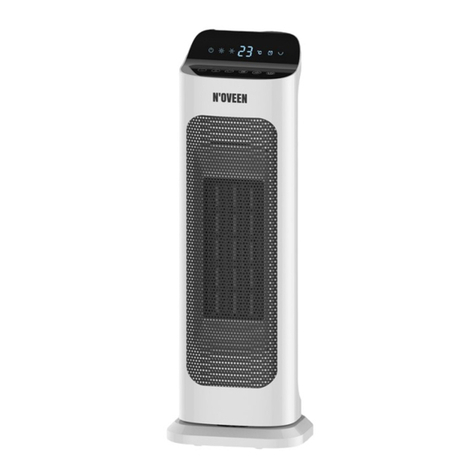
N'oveen
N'oveen SMART PTC2000 user manual
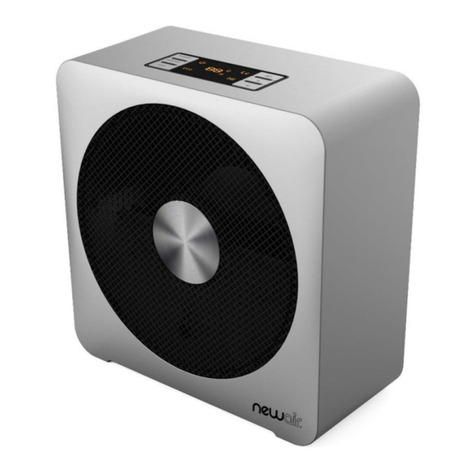
New Air
New Air QuietHeat15S owner's manual
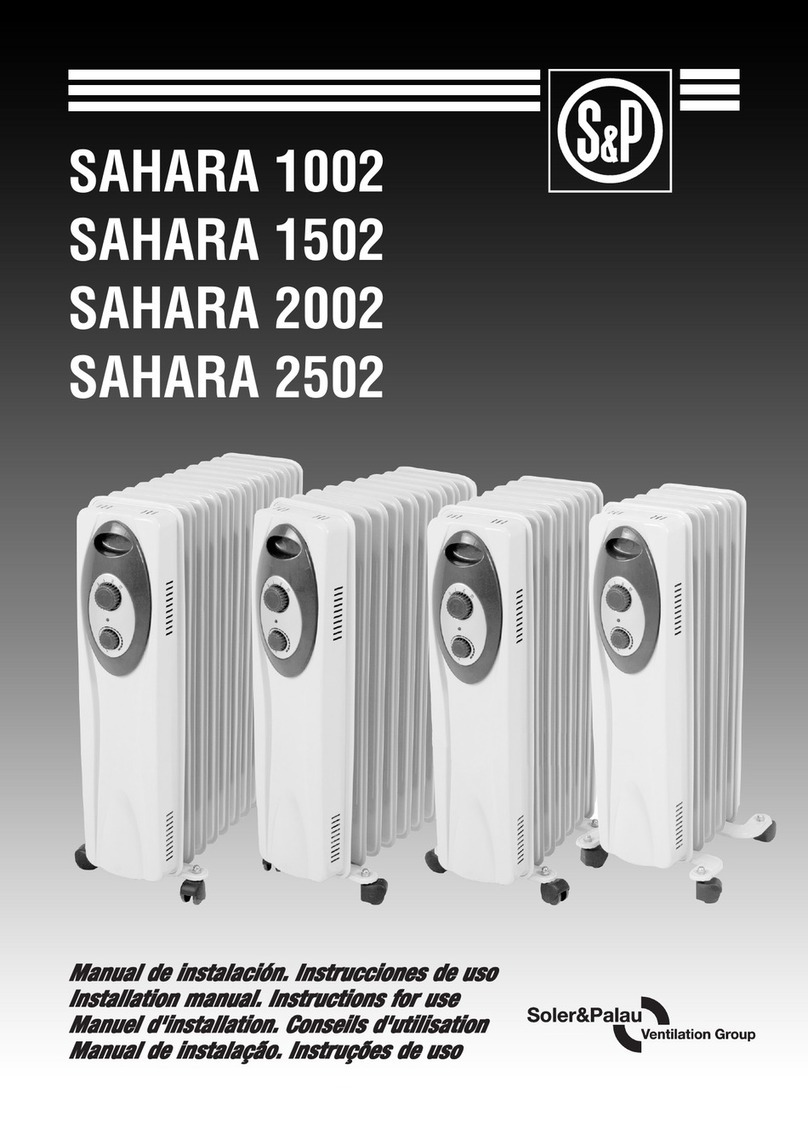
Soler & Palau
Soler & Palau SAHARA Series Important instructions
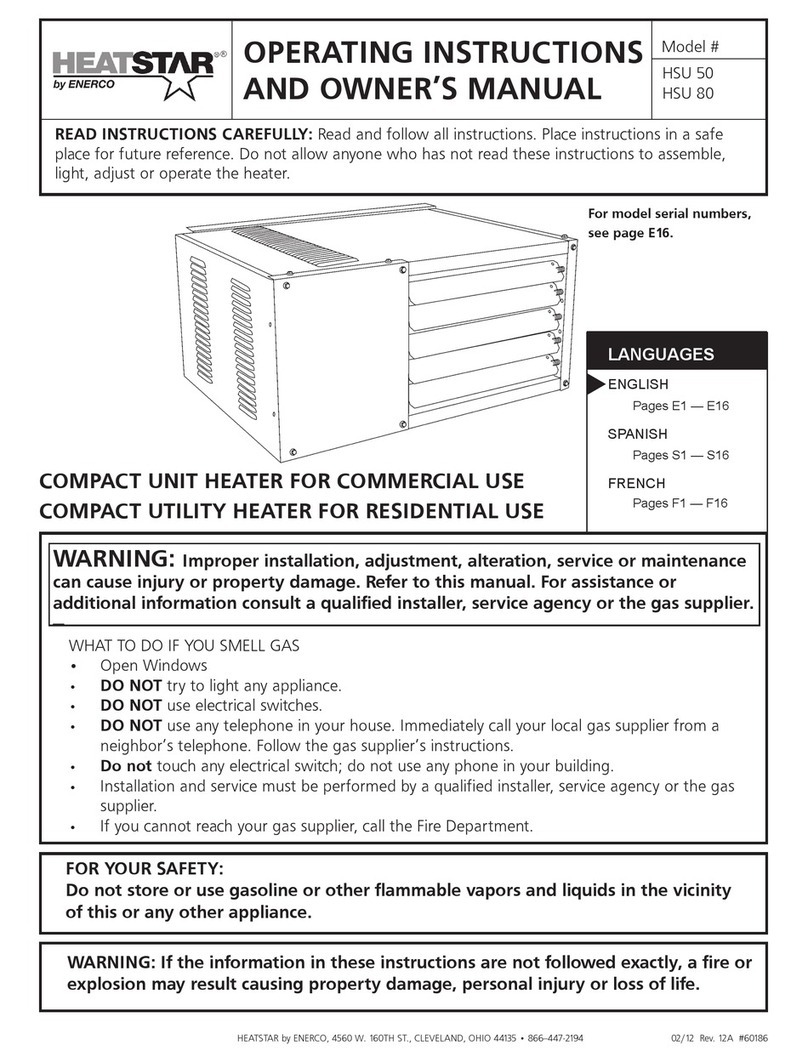
ENERCORP
ENERCORP HeatStar HSU80 Operating instructions and owner's manual
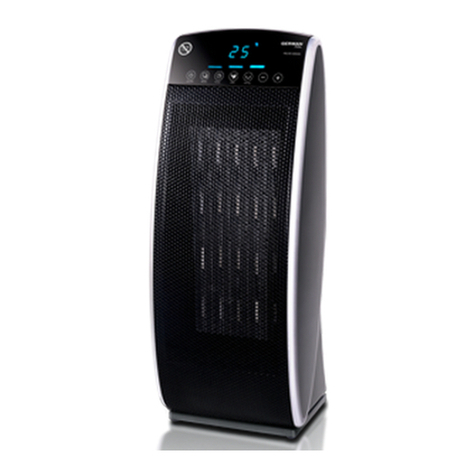
German pool
German pool HTF-420 user manual
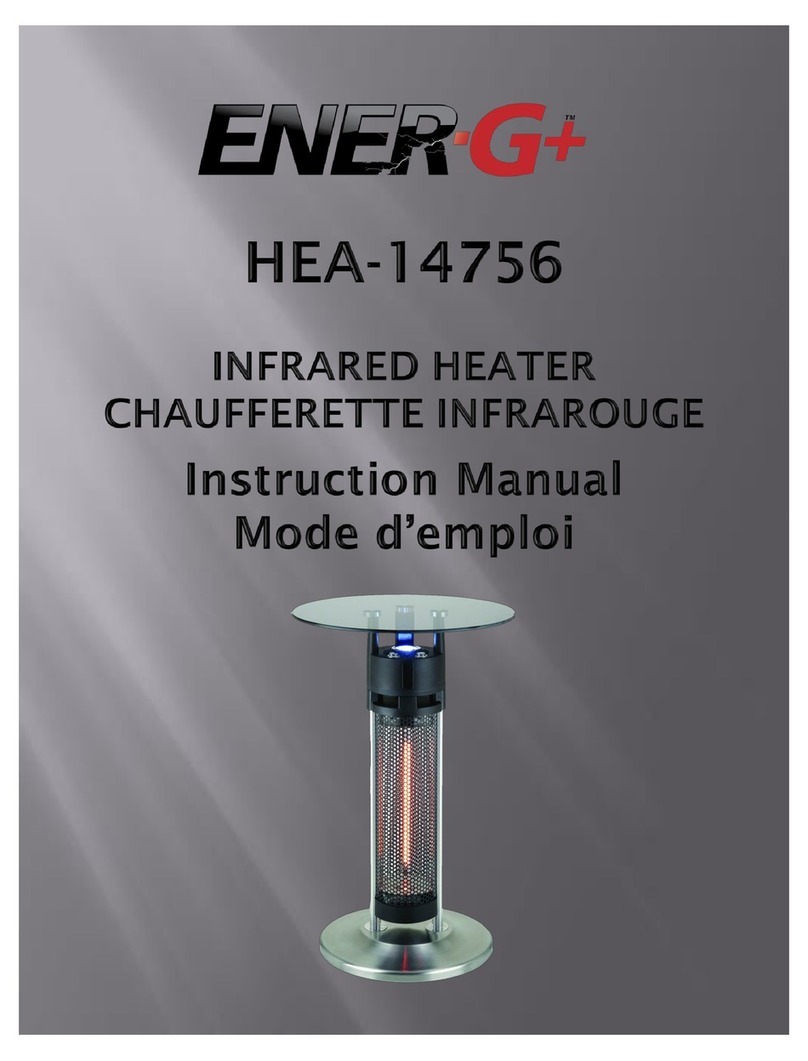
Ener-G+
Ener-G+ HEA-14756 instruction manual
